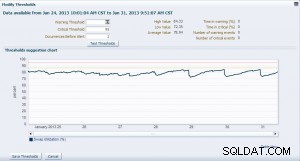Prova questo:http://www.sqlfiddle.com/#!3/c3365/ 20
with s as
(
select *, row_number() over(partition by membercode order by startdate) rn
from tbl
)
,gaps as
(
select a.membercode, a.startdate, a.enddate, b.startdate as nextstartdate
,datediff(d, a.enddate, b.startdate) as gap
from s a
join s b on b.membercode = a.membercode and b.rn = a.rn + 1
)
select membercode
from gaps
group by membercode
having sum(case when gap <= 1 then 1 end) = count(*);
Vedi la progressione della query qui:http://www.sqlfiddle.com/#!3/ c3365/20
Come funziona, confronta la data di fine corrente con la data di inizio successiva e controlla la differenza di date:
with s as
(
select *, row_number() over(partition by membercode order by startdate) rn
from tbl
)
select a.membercode, a.startdate, a.enddate, b.startdate as nextstartdate
,datediff(d, a.enddate, b.startdate) as gap
from s a
join s b on b.membercode = a.membercode and b.rn = a.rn + 1;
Uscita:
| MEMBERCODE | STARTDATE | ENDDATE | NEXTSTARTDATE | GAP |
--------------------------------------------------------------
| 1 | 2010-01-15 | 2010-01-20 | 2010-01-19 | -1 |
| 1 | 2010-01-19 | 2010-01-22 | 2010-01-20 | -2 |
| 1 | 2010-01-20 | 2010-01-25 | 2010-01-26 | 1 |
| 2 | 2010-01-20 | 2010-01-25 | 2010-01-30 | 5 |
| 2 | 2010-01-30 | 2010-02-05 | 2010-02-04 | -1 |
Quindi controlla se un membro ha lo stesso numero di reclami senza interruzioni rispetto al totale dei reclami:
with s as
(
select *, row_number() over(partition by membercode order by startdate) rn
from tbl
)
,gaps as
(
select a.membercode, a.startdate, a.enddate, b.startdate as nextstartdate
,datediff(d, a.enddate, b.startdate) as gap
from s a
join s b on b.membercode = a.membercode and b.rn = a.rn + 1
)
select membercode, count(*) as count, sum(case when gap <= 1 then 1 end) as gapless_count
from gaps
group by membercode;
Uscita:
| MEMBERCODE | COUNT | GAPLESS_COUNT |
--------------------------------------
| 1 | 3 | 3 |
| 2 | 2 | 1 |
Infine, filtrali, membri senza lacune nelle loro affermazioni:
with s as
(
select *, row_number() over(partition by membercode order by startdate) rn
from tbl
)
,gaps as
(
select a.membercode, a.startdate, a.enddate, b.startdate as nextstartdate
,datediff(d, a.enddate, b.startdate) as gap
from s a
join s b on b.membercode = a.membercode and b.rn = a.rn + 1
)
select membercode
from gaps
group by membercode
having sum(case when gap <= 1 then 1 end) = count(*);
Uscita:
| MEMBERCODE |
--------------
| 1 |
Tieni presente che non è necessario eseguire COUNT(*) > 1 per rilevare i membri con 2 o più reclami. Invece di usare LEFT JOIN , utilizziamo JOIN , questo eliminerà automaticamente i membri che devono ancora avere una seconda richiesta. Ecco la versione (più lunga) se scegli di utilizzare LEFT JOIN invece (stesso output di cui sopra):
with s as
(
select *, row_number() over(partition by membercode order by startdate) rn
from tbl
)
,gaps as
(
select a.membercode, a.startdate, a.enddate, b.startdate as nextstartdate
,datediff(d, a.enddate, b.startdate) as gap
from s a
left join s b on b.membercode = a.membercode and b.rn = a.rn + 1
)
select membercode
from gaps
group by membercode
having sum(case when gap <= 1 then 1 end) = count(gap)
and count(*) > 1; -- members who have two ore more claims only
Ecco come visualizzare i dati della query precedente prima del filtraggio:
with s as
(
select *, row_number() over(partition by membercode order by startdate) rn
from tbl
)
,gaps as
(
select a.membercode, a.startdate, a.enddate, b.startdate as nextstartdate
,datediff(d, a.enddate, b.startdate) as gap
from s a
left join s b on b.membercode = a.membercode and b.rn = a.rn + 1
)
select * from gaps;
Uscita:
| MEMBERCODE | STARTDATE | ENDDATE | NEXTSTARTDATE | GAP |
-----------------------------------------------------------------
| 1 | 2010-01-15 | 2010-01-20 | 2010-01-19 | -1 |
| 1 | 2010-01-19 | 2010-01-22 | 2010-01-20 | -2 |
| 1 | 2010-01-20 | 2010-01-25 | 2010-01-26 | 1 |
| 1 | 2010-01-26 | 2010-01-30 | (null) | (null) |
| 2 | 2010-01-20 | 2010-01-25 | 2010-01-30 | 5 |
| 2 | 2010-01-30 | 2010-02-05 | 2010-02-04 | -1 |
| 2 | 2010-02-04 | 2010-02-15 | (null) | (null) |
| 3 | 2010-02-15 | 2010-03-02 | (null) | (null) |
MODIFICA sul chiarimento dei requisiti:
Sul tuo chiarimento, volevi includere anche i membri che devono ancora avere una seconda richiesta, invece fai questo:http://sqlfiddle.com/#!3/c3365/22
with s as
(
select *, row_number() over(partition by membercode order by startdate) rn
from tbl
)
,gaps as
(
select a.membercode, a.startdate, a.enddate, b.startdate as nextstartdate
,datediff(d, a.enddate, b.startdate) as gap
from s a
left join s b on b.membercode = a.membercode and b.rn = a.rn + 1
)
select membercode
from gaps
group by membercode
having sum(case when gap <= 1 then 1 end) = count(gap)
-- members who have yet to have a second claim are valid too
or count(nextstartdate) = 0;
Uscita:
| MEMBERCODE |
--------------
| 1 |
| 3 |
La tecnica consiste nel contare il nextstartdate del membro , se non hanno una data di inizio successiva (ad esempio count(nextstartdate) = 0 ) allora sono solo rivendicazioni singole e valide, quindi allega semplicemente questo OR condizione:
or count(nextstartdate) = 0;
In realtà, anche la condizione seguente sarà sufficiente, volevo però rendere la query più auto-documentante, quindi consiglio di contare sulla data di inizio successiva del membro. Ecco una condizione alternativa per il conteggio dei membri che devono ancora avere una seconda richiesta:
or count(*) = 1;
A proposito, dobbiamo anche cambiare il confronto da questo:
sum(case when gap <= 1 then 1 end) = count(*)
a questo (dato che stiamo usando LEFT JOIN ora):
sum(case when gap <= 1 then 1 end) = count(gap)




